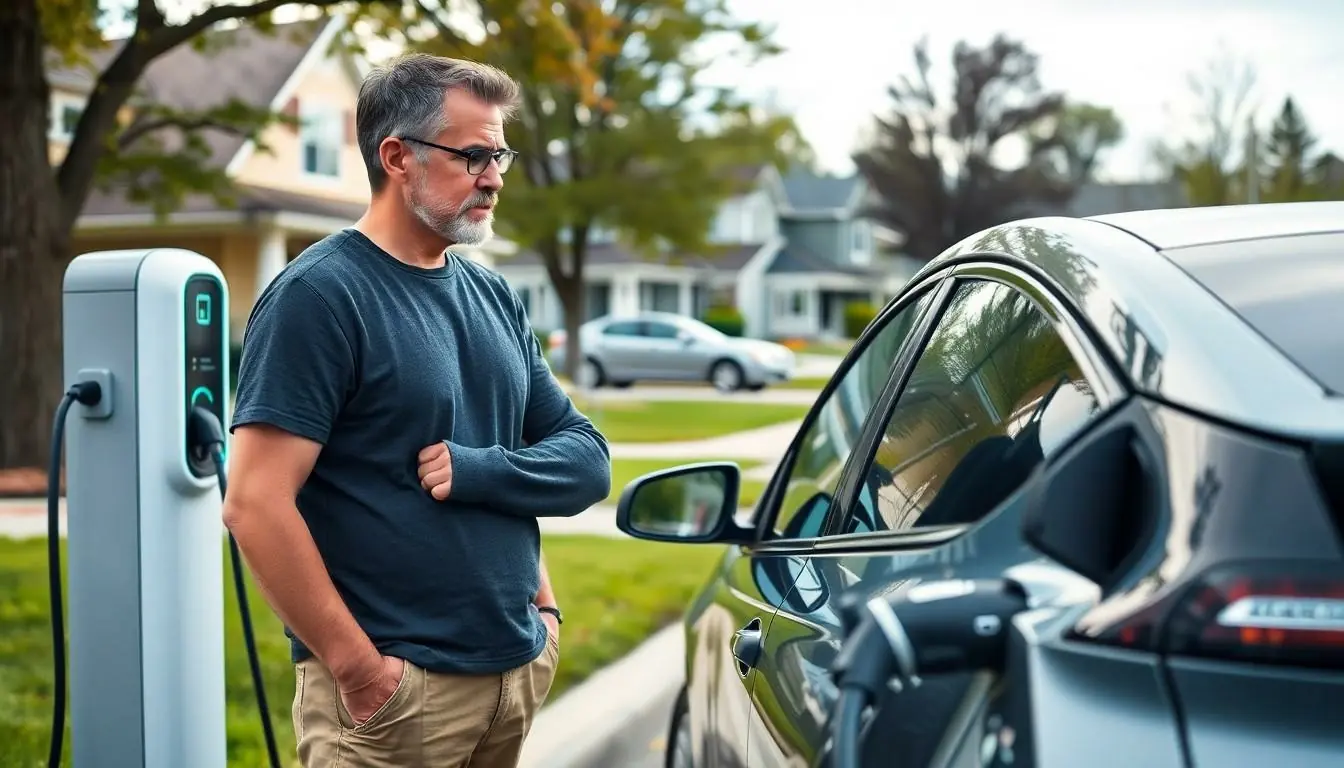Electric vehicles (EVs) are often hailed as the future of transportation, promising a cleaner and greener planet. But before jumping on the eco-friendly bandwagon, it’s crucial to consider the flip side. While they might be whisper-quiet and guilt-free, EVs come with their own set of quirks that could make even the most devoted environmentalist raise an eyebrow.
From range anxiety that can turn a quick trip to the grocery store into a high-stakes adventure, to charging times that could rival a good Netflix binge, the disadvantages of electric vehicles are worth exploring. And let’s not forget the not-so-eco-friendly production processes that can leave a sour taste. Buckle up as we dive into the not-so-shiny aspects of EV ownership that might just make you reconsider your next ride.
Table of Contents
ToggleOverview of Electric Vehicles
Electric vehicles (EVs) represent a shift towards sustainable transportation. Many consumers appreciate the lower operating costs and reduced greenhouse gas emissions associated with EVs. Despite these advantages, several disadvantages warrant consideration.
Range anxiety remains a significant concern for potential EV owners. Current models typically offer a driving range of 150 to 370 miles on a single charge, which may not meet the needs of all users. Long-distance travel can be challenging, especially in areas lacking charging infrastructure.
Charging times can exceed expectations. Fast chargers may only reduce the charging duration to about 30 minutes, while standard outlets can take several hours or even overnight to fully charge the vehicle. Users may find it inconvenient to plan their trips around charging stations.
Production processes for electric vehicles can be environmentally damaging. Mining for lithium, cobalt, and nickel has raised significant ecological and ethical issues. These materials are essential for battery manufacturing, but their extraction can lead to habitat destruction and human rights violations in some regions.
Cost implications also factor heavily into the decision-making process. While federal and state incentives help offset initial expenses, EVs often cost more than traditional gasoline-powered cars. Maintenance costs may also rise due to specialized parts and services required for electric models.
Overall, while electric vehicles offer potential benefits, several drawbacks must be taken into account. Awareness of these disadvantages ensures consumers make informed decisions when considering their next vehicle.
Environmental Concerns

Electric vehicles pose environmental challenges despite their cleaner image. Two significant areas of concern involve battery production and disposal.
Battery Production Impact
Battery production significantly affects the environment. Mining for materials such as lithium, cobalt, and nickel often results in habitat destruction and pollution. Countries like the Democratic Republic of Congo, which supplies over 60% of cobalt, face severe ecological and social issues due to unregulated mining practices. Additionally, the carbon footprint from the manufacturing process can offset some of the emissions reductions achieved during vehicle operation. Reports indicate that producing a single electric vehicle battery can emit approximately 150 to 200 kilograms of carbon dioxide. These factors complicate the narrative surrounding electric vehicles as an entirely green alternative.
Disposal and Recycling Issues
Disposal and recycling of electric vehicle batteries present further environmental challenges. Many batteries end up in landfills, where they can leak harmful chemicals into the soil and water. Current recycling rates for EV batteries are estimated at around 5%, leaving a vast majority unrecycled. The complexity of lithium-ion batteries complicates recycling efforts, as their components require specialized processes. Furthermore, recycling systems lack infrastructure to handle the increasing number of batteries reaching end-of-life. As electric vehicle adoption grows, addressing these disposal and recycling issues becomes crucial for minimizing environmental harm.
Economic Disadvantages
Electric vehicles (EVs) come with notable economic drawbacks that potential buyers should consider.
High Initial Costs
Purchasing an electric vehicle often involves a higher upfront investment compared to traditional gasoline-powered cars. As of 2023, the average price for an electric vehicle ranges from $40,000 to $60,000, whereas many gasoline counterparts start below $30,000. Incentives exist to offset some costs; however, they may not fully bridge the gap. Limited availability of affordable models further compounds the issue, restricting options for budget-conscious consumers. Financing options for EVs can also differ, as some lenders impose stricter terms due to perceived risks. Higher initial costs can deter buyers, even with long-term savings on fuel and maintenance.
Limited Resale Value
Selling an electric vehicle often leads to concerns about depreciation and resale value. Over the past few years, EVs have shown an average resale value reduction of around 50% after three years, compared to about 40% for gasoline vehicles. Factors like rapid technological advancements and improvements in battery life can further decrease the perceived value of older models. Limited consumer demand in certain markets adds to the challenge, as prospective buyers may hesitate to invest in a used EV. The evolving marketplace often results in a higher percentage of depreciation for EVs. These financial factors contribute to limited resale value, impacting long-term ownership satisfaction.
Infrastructure Challenges
Infrastructure challenges significantly hinder the widespread adoption of electric vehicles (EVs). Barriers include charging station availability and range limitations.
Charging Station Availability
Charging station availability remains a critical issue for EV users. Across the United States, approximately 112,000 public charging outlets exist, compared to over 168,000 gas stations. Many regions lack adequate coverage, especially in rural areas. Drivers may face difficulties finding charging stations on long trips. Moreover, the distribution of fast charging stations is uneven, with urban centers possessing higher concentrations. Inadequate infrastructure can lead to inconvenience and range anxiety, deterring potential EV buyers.
Range Limitations
Range limitations also pose significant concerns for EV drivers. Most electric vehicles provide a driving range between 150 to 370 miles on a single charge. Some consumers may find this range insufficient for long-distance travel. As a result, range anxiety becomes an issue, particularly for those accustomed to gasoline vehicles with longer ranges. Frequent charging breaks may interrupt travel plans. Various manufacturers are developing models with increased range; however, many current options still fall short of user expectations for flexibility.
Performance and Maintenance Issues
Performance and maintenance issues can significantly impact the user experience of electric vehicles (EVs). Understanding these drawbacks helps potential buyers make informed choices.
Limited Model Variety
Limited model variety can restrict options for consumers. While the EV market is growing, choices often remain fewer than those for gasoline vehicles. Many popular vehicle categories, such as pickup trucks or specific luxury models, lack electric counterparts. Buyers seeking specific features might find themselves disappointed by the limited selection. Diverse preferences in vehicle style and function often remain unaddressed in current offerings. As manufacturers expand their lineups, the hope is for a broader range of models to meet varying consumer demands, but this hasn’t yet materialized universally.
Long Charging Times
Long charging times present a notable inconvenience for EV users. Fast chargers typically require around 30 minutes to replenish battery levels, while standard outlets can take several hours. For those needing to charge on-the-go, these waiting periods can disrupt daily routines or travel plans. Expecting a quick fill-up like gasoline may lead to frustration. Charging stations are increasingly available, yet the time spent waiting for a recharge is still significantly longer than refueling with conventional fuel. Convenience often sways consumers, and longer charging durations might deter potential buyers who prioritize efficiency above all else.
Electric vehicles offer an innovative solution for cleaner transportation but come with notable disadvantages that deserve careful consideration. Range anxiety and lengthy charging times can deter potential users from fully embracing this technology. Additionally the environmental impact of battery production and disposal raises serious concerns that can’t be overlooked.
Economic factors also play a significant role with higher initial costs and depreciation rates affecting long-term ownership satisfaction. Infrastructure challenges further complicate the transition to EVs as the availability of charging stations remains limited in many areas.
While advancements are being made in the EV market the existing drawbacks highlight the need for consumers to weigh their options before making a decision. Understanding these factors ensures a more informed choice when considering an electric vehicle.



